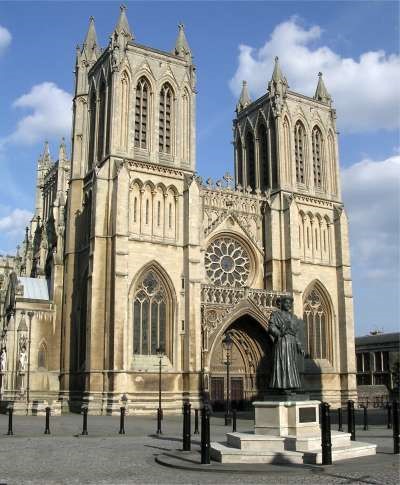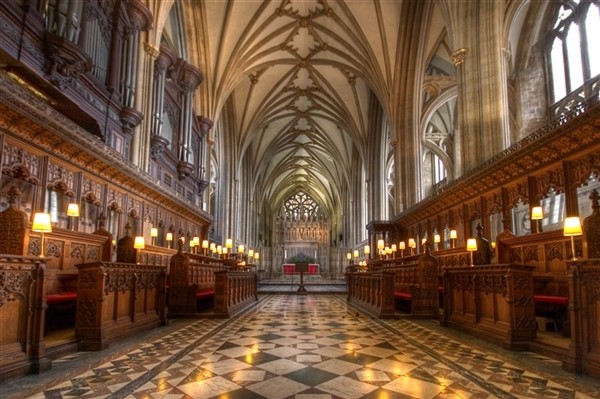The Cathedral
Architecturally stunning, once described as “one of the great masterpieces of European gothic architecture”, occupying what is arguably the most important site in the area and boasting some of the most beautiful stained glass windows in the country, the Cathedral was originally founded as an Abbey in or around 1140. It was in 1542 that Henry VIII (sometime between divorces, beheadings and multiple marriages).
Grade I listed, with a floor area of over 2000m² and nearly 100m long, the Cathedral’s Nave, Choir and Aisles are all the same height, forming a large hall: Bristol Cathedral is hence the major example of a ‘Hall Church’ in Great Britain and one of the finest anywhere in the world.

The Cathedral contains some of the finest Romanesque work in this country, with the magnificent Chapter House and Vestibule, and surviving archways of the Abbey Gatehouse.
Within the Cathedral are many treasures such as the late Saxon carving depicting the “Harrowing of Hell” (acknowledged to be one of the finest Saxon carvings in England) the Gothic candelabrum from the Temple Church (the oldest brass candelabrum in the country) carved oak misericords and fine monuments.
The Cathedral is of outstanding importance to the history of the area and to modern life in the city centre.
The incident
A small stack of plastic chairs being used as the principal ingredient, a fire was deliberately set by an unknown miscreant in the Elder Lady Chapel, immediately adjacent to the stone Quire screen.
The fire was put out quickly by members of staff who, immediately on discovery, discharged dry powder and other extinguishers stored nearby.
The damage
The Quire screen was damaged by heat from the blaze, as was the stone floor immediately beneath the point of origin, and the fire generated volumes of smoke/soot which percolated across the Cathedral (see photographs 7 and 8).
On our recommendation, the firm of Forensic Scientists, Hawkins, was engaged by the Cathedral’s Architects, Seymour and Bainbridge, to establish whether the soot deposits, produced by the fire, contained corrosive contaminants: where they are present post-fire, such coverings can be catastrophic to such a building’s fine components and any affected contents such that immediate action is necessary to arrest their (usually acidic) degenerative effects. The powder from the discharged fire extinguishers was also an area of potential concern.
Extensive tests and contamination profiles were completed by Dr Robert Edwards of Hawkins who was able to report that the analysed soot particle deposits were “close to pH neutral”: this relieved the need for immediate arrestive action.
A number of photographs, some illustrating the nature and extent of the damage caused by the fire.
The Response
On notification of the incident, the appointed Chartered Loss Adjuster brought in Continuity to work with the Cathedral’s Architects, Seymour and Bainbridge of Winchester, in the restoration work required.
The first visit of one of the Continuity’s Directors and UK Operations Manager to the Cathedral, to assess the situation and give immediate advice, took place within 24 hours of the incident and within a few hours of the point at which we were instructed.
At a subsequent plenary meeting of all interested parties, including Continuity’s Health and Safety Officer, the best means and methods of decontaminating the various affected superstructure components and the contents were discussed, a plan was drawn up and agreed upon. After completing triage and risk assessments, method statements and estimates, we began the 3 phased decontamination exercises required – within 48 hours of our instructions to proceed.
The restoration works
A full-time project manager, Gavin Smith, was charged with responsibility for all aspects of the required remedial works and, through all phases, he worked with a number of other project managers, supervisors and 8 operatives, all trained and experienced in the sensitive and painstaking decontamination of the many delicate and valuable features found in historic buildings such as this.
Bristol Cathedral receives countless visitors and school groups annually and it was important that it remained open to the public throughout the project: to enable us to complete the work required of them safely and properly, areas of the Cathedral were cordoned off, but there was still minimal disruption caused to daily services, prayer meetings, concerts, civic and other events, and none in most cases.
Phase 1 constituted the careful and methodical decontamination of a number of delicate and ornate (and extremely valuable) brass and silverware items (candlesticks, crosses, lecterns, altar rails and the like) which were restored in exact accordance with the processes agreed. This involved firstly vacuuming the items concerned, utilising machines with HEPA filters and specially selected brushes, along with soft-bristled camel hair brushes.
The items were then carefully polished using E-cloths (organic, environmentally friendly, micro fibre and chemical-free materials).
Throughout this part of the process, all of our staff wore 100% organic cotton gloves – so nothing was scratched and there were no blemishes left.
These items were selected to comprise Phase 1 of the project because it was feared that the contaminants produced by the fire would quite possibly negatively affect the metals concerned.
Phase 2 involved the main restoration project, which required working, in a similar manner and with similar equipment and materials, practically throughout the eastern half of the Cathedral, starting with the Quire: the team methodically, assiduously and very gently vacuumed the numerous superstructure components, also using soft-bristled camel hair brushes and, to decontaminate some areas of affected stonework, specially formulated “soot sponges”. Contents items were generally similarly approached. Where appropriate, items such as the ornate carved painted wooden angels were washed using weak pH-neutral soap solutions and very soft brushes.
A relatively small scaffold structure was erected to facilitate the thorough decontamination of the stone reredos (photographs # 6 and 12 refer).
Phase 3, which comprised the similar decontamination of the painted, vaulted ceiling, above the seat of the fire and elsewhere, as well as a number of smoke covered stained glass windows, including 17th Century heraldic glass in the east window of the North Choir Aisle, necessitated the erection of a further scaffold structure to facilitate these works. The ceiling is over 15 metres above ground level.

Conclusion
The main restoration work – Phases 1 & 2 – was completed in 10 days, Phase 3 taking a further 4 days.
We liaised throughout with the appointed Architects, the Reverend et al. On conclusion of our work in any case we ask Policyholders to complete a satisfaction note. The Reverend commented in that obtained in this case: “The team has worked well on-site and there has been minimal disruption to the Cathedral. My thanks to Gavin and the team for excellent service.”